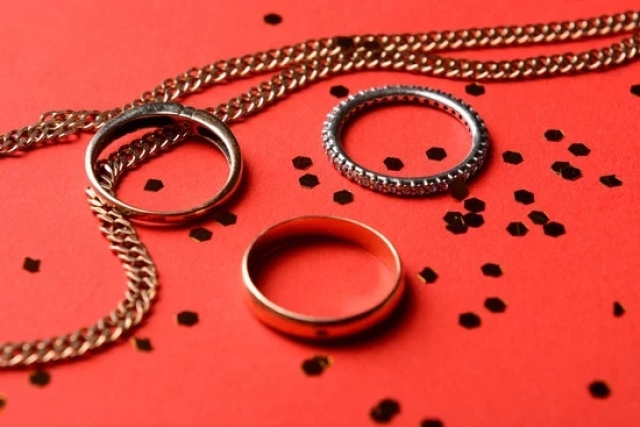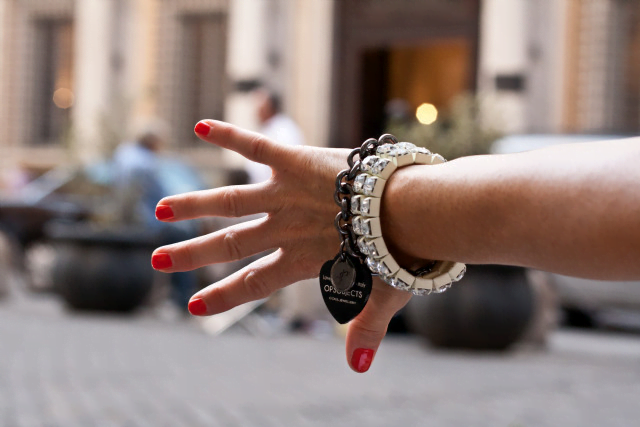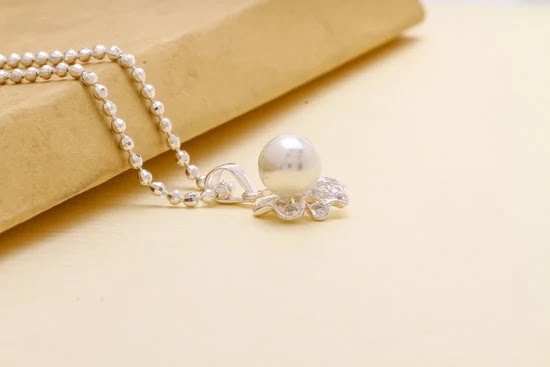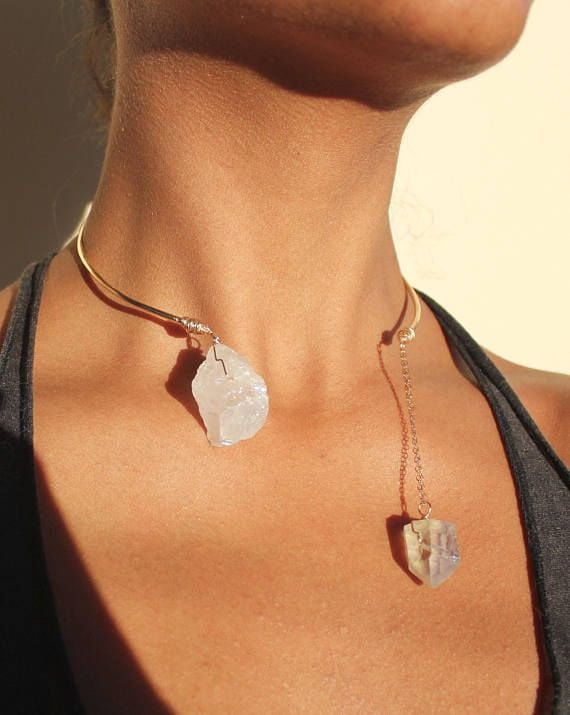The history of wearing jewelry is extensive and dates back thousands of years. Wearing jewelry has been a practice in almost all societies, as most ancient civilizations used jewelry not only for its decorative appeal but as a symbolic means to signify social rank and status. While each civilization had its own unique style of adornment, wearing jewelry was universal among cultures.
In the Mediterranean region, people have been wearing jewelry since the Paleolithic era. During this period, Neanderthals are thought to have worn various types of adornment such as stones and shells for their symbolic meaning.
These items were often believed to bring good luck or protection from evil spirits. In Ancient Greece, jewelry was an important form of expressing one’s wealth and power; items like gold bands decorated with intricate designs were common among the elite class while lesser means would generally wear bronze or iron pieces instead.
Jewelry was popular in other parts of the world too, particularly in India and China. In India, jewelry was viewed as a symbol of devotion to gods or deities and certain kinds were associated with specific gods and goddesses such as Lakshmi, Ganesh, and Shiva. In China during the Zhou Dynasty (1046-256 BC), tassels known as yu ping were made using jade that symbolized power and prestige among the emperor’s court members.
Jewelry-making techniques became increasingly sophisticated over time due to innovations such as lost-wax casting which allowed for much finer detail work than before; this method is still used today by craftsmen who specialize in reproducing ancient artworks for museums or collectors. Jewelry also slowly became more affordable thanks to mass production techniques that allowed them to create cheaper imitations from base metals that still had plenty of aesthetic appeal without breaking the bank.
Ultimately, it isn’t hard to see why wearing jewelry has come so far throughout history – it serves both practical and ornamental purposes and continues to be popular today all around the world.
Exploring Jewelry Designs Through the Ages
Jewelry has been worn for both aesthetic and symbolic reasons since the earliest societies. People of various cultures can identify their ethnic and social identities through the different pieces of jewelry they wear. In ancient African civilizations, necklaces, bracelets, and other forms of jewelry were believed to provide protection. The colors and shapes of these pieces had special meanings as well.
Similarly, in Ancient Egypt, jewelry was made from precious materials such as gold, lapis lazuli and precious stones. Some pieces showcased complex hieroglyphic carvings representing ideas of life after death and spiritual beliefs. Jewelry was also an important tool expressing rank in society – both its design and material communicated status within the community.
In Medieval Europe during the 6th century, jewels began to symbolize power, wealth and a status above that of skilled craftsmen or peasants who wore no jewelry at all. For example, men would receive lavish rings from powerful leaders as symbols of loyalty or free membership amongst noblemen circles. Rings were given at ceremonies involving oaths of fealty or combat in tournaments meant to show loyalty to a master lord or king.
Modern jewelry today still serves many diverse purposes – it is used for fashion statements, expressions of love and loyalty or simply for beauty’s sake alone. It can be made with a vast range of materials nowadays too – diamonds may still be popular but glass beads earrings are seen as fashionable too.
Some Examples Of Jewelry Designs Through History
- Ancient Africa – Colorful necklaces crafted from colorful stones.
- Ancient Egyptian – Gold pendants inscribed with hieroglyphics.
- Medieval Europe – Lavish rings presented by powerful leaders as symbols of loyalty.
- Modern Jewelry – Diamonds rings along with glass bead earrings.
Earliest Examples of Jewelry in Human History
The history of jewelry dates back to the prehistoric era, when primitive humans first began wearing amulets and other decorations. This is evidenced by body ornaments discovered in archaeological digs worldwide. For example, 1) beads made from animal bones, shells, and ivory have been found in numerous digs throughout Europe and North America. In addition, archaeologists have uncovered a variety of jewelry crafted from copper and silver in the Middle East.
Jewelry played an important part in many early civilizations as both an artistic and spiritual expression. 2) Ancient Egyptians, for instance, used various gold and precious gems to symbolize wealth and power. Meanwhile, Buddhists often used jewelry to depict sacred symbols of enlightenment. Similarly, many Indigenous cultures throughout North America used jewelry not just for personal ornamentation but also as a visual representation of their beliefs and customs.
In recent times western culture has romanticized the wearing of jewelry by its association with wealth and status symbols. 3) Modern engagement rings are perhaps one of the most visible examples; with certain gems such as diamonds being exceptionally prized due to their rarity and monetary value amongst buyers. In addition to cultural reasons for wearing jewelry there are also modern fashion trends which dictate what styles or materials are popular amongst specific demographics for decorative purposes.
The Symbolic Meaning Behind Jewelry Within Ancient Cultures
Jewelry has been worn by people from around the globe since ancient times. Its design, materials, and styles have changed over time but its deep symbolic meaning within many cultures remains the same. Among the earliest known examples of jewelry are pieces found in graves from 30,000 BC that were made of bone and ivory.
This demonstrates that even early on jewelry was seen as symbolically valuable and was believed to protect the wearer after death. Over time, different cultures began to use materials such as metals for their jewelry creations as these offered more durability and served practical purposes like monetary wealth or fashion.
In Ancient Egypt, jewelry held strong spiritual meaning – pieces were often associated with divinity and divine powers which could then be transferred unto their wearers. Gold was a highly sought-after material located along the rivers of Egypt so its use became a symbol of wealth and power.
Jewelry was also engraved with hieroglyphs that referred to gods or important messages related to protection for example. People during this period also placed gems into their pieces which were thought to ward off evil spirits or even granted special healing properties something which is still practiced in parts of the world today.
The Ancient Greeks were also well known for their exquisite designs – they focused on creating forms based on natural elements they observed around them such as plants, animals, or constellations across the night sky.
During this period, Greek women would adorn themselves heavily in jewelry such as earrings, necklaces, headbands and pendants – together these formed representations of love, union with nature and homage to figures from mythology & legends which had become commonplace in everyday life in those societies at that time.
Wearing of these trinkets was not just seen as ornamental but had cultural significance too – it held importance for example when seeking a marital partner. In some cases even slaves wore intricate gold beads meant to signify how wealthy their owners were.
Jewelry as a Representation of Social Status and Wealth
The practice of wearing jewelry dates back centuries and began with the ancient civilisations who utilized it for its aesthetic value as well as its religious significance. Through out history, from Rome to Ancient Egypt, jewelry has been used to signify social status and wealth.
In some cultures and societies like those found in India, it is a tradition that one will wear jewels symbolic of their marital status, (some times entire wedding sets-from necklaces to anklets) and various rings which represent their social standing in life. Jewelry is still often an indication of higher class status in society.
Today we wear jewelry for many reasons outside that of simply communication of status and wealth. Some individuals may accessorise themselves with gold and sparkles to add personality to an outfit or even because it signifies a special occasion or milestone – such as graduation or birthday present. Either way, the symbolic associations use have changed over the years but enjoy adorning our bodies with bauble remains constant throughout time and lense cultures.
It’s no wonder that this has remained a prominent feature throughout the ages, given how much joy such items bring us. Who doesn’t feel a little extra sparkle upon seeing a glimmering diamond?
Whether someone is donning chains covered in diamonds or just a simple nose ring, humans all around the world have continued to decorate themselves these accessories, bringing people together through fashion and culture alike as they carry on stories from generation to generation while crafting new memories along the way.
Changes in Jewelry Designs Through History
Jewelry is a form of adornment that has been part of human culture for thousands of years. Jewelry has evolved in design and purpose over time, depending on the trends and customs of various civilizations. Below are some notable changes in the history of jewelry throughout different cultures:
- The earliest known pieces of jewelry date back to 40,000 years ago in the Neolithic era where shells, teeth, stone, and bones were used as decorative items.
- Ancient Egyptians used gold and gemstones in necklaces, earrings and bracelets depicting their gods or important people.
- Greeks and Romans also heavily incorporated precious metals but began to add visual narratives to designs such as battles or scenes from mythology.
In Medieval Europe designs shifted away from representing stories to more intricate shapes and patterns due to increased access to tools. They also added enamel accents to bring more color into their pieces. Metalworking techniques flourished which allowed craftsmen to make more intricate designs than ever before. During this era lockets became popular for holding portraits or other sentimental objects while brooches with pins served as an early type of fastener.
By the 1600s craftsmanship had become a trade as demand for finer quality jewelry spread across all classes. Goldsmiths combined gemstones with metalwork creating masterpieces like mounted and bejeweled orbs that adorned courtly events or decorated Tudor collars with jewels cascading down the front.
Then during the Rococo period complex designs made with multiple layers of diamonds became commonplace. It was during this era that bracelets first became fashionable, differing by region such as chain bracelets common among Italians or heavy diamond-studded varieties popular among French aristocrats at the time.
As materials changed over time so did fashion styles – some eras emphasizing less extravagant pieces while others leaned toward grandeur. From natural materials such as shells and stones to modern computing technologies allowing for precise 3D printing; designs have expanded beyond imagination underscoring how constant evolution is entwined in jewelry’s past even until today’s modern age.
How Jewelry Has Adapted With Modern Trends
The history of wearing jewelry dates back thousands of years and can be seen in artifacts from ancient Egyptian tombs. Jewelry has been used to express wealth, power, beauty, religious beliefs, and love throughout the centuries. From ancient earrings crafted out of stone to delicately engraved watches and rings adorned with diamonds today, one thing that remains constant in the design of jewelry is its symbolism.
Modern trends indicate that jewelry has evolved as fashion trends have changed throughout the decades. During the 1920s, designer Coco Chanel popularized elegant pearl necklaces and earrings in jagged designs that were a stark contrast to traditional styles at the time.
The mid-20th century saw an emphasis on big statement pieces that made bold statements about status and power. By the late 1990s, minimalist styles became popular along with dainty earrings and necklaces featuring fine metals such as sterling silver and gold vermeil.
Nowadays, people are experiencing a resurgence of traditional jewelry yet have new options when it comes to finding meaningful pieces that represent their own personal style. This trend has been especially evident through the increasing popularity of custom jewelry which allows customers to personalize a piece based on colors, materials, or messages they want to add to their accessory.
Additionally, new materials have emerged such as sustainable wood beads mixed with additional organic elements for a stylish but eco-friendly look.
Customizable charms and stones are now widely available giving contemporary jewelry makers more creative freedom than ever before. As technology continues advancing design possibilities within modern fashion trends, we can expect for modern jewelry designers to continue pushing boundaries while honoring the cherished traditions from which these pieces were inspired by thousands of years ago.
How Wearing Jewelry Is Viewed Across Different Cultures and Religions
Since prehistoric times, humans have worn jewelry. Remains of jewelry discovered by archaeologists suggest that jewelry was in use around 75,000 years ago. Materials used to create this early jewelry included bone, shells and ivory. Juxtaposed with rare stones, metals such as gold and silver were also employed in these pieces. Throughout history and many different cultures across the world, wearing jewelry has had many different meanings and achieved a variety of purposes.
In the ancient Mesopotamian civilization, wearing cuffs was believed to confer strength upon its wearer along with prosperity and good health. In Egypt during the Early Dynastic Period (c 2925 – c 2575 BC) rings were worn to signify religious devotion whereas scarabs represented eternal life; other forms of jewellery were highly symbolic of money and royalty while amulets held protective powers.
During the Indian Vedic Age (1500 – 500 BC), simple ornaments made from gold connoted purity of body and serenity of mind, opening up the internal senses for religious enlightenment.
In contemporary Christianity it is traditional for a woman to wear a wedding ring on her left ring finger; though less commonplace today some people also still choose to have religious symbols tattooed or engraved onto their bodies for purposes including protection from evil spirits or sometimes simply as beautiful decoration.
This custom can be seen in Jewish practice too where the small pierced boxes known as mezuzah’s are hung on door frames containing inscribed scripts from the Holy Books of Torah commonly written on parchment paper inside a mezuzah case made out of animal bone or leather.
Similarly due to Islamic laws prohibiting certain body decorations amongst women which might entice men away from spiritual causes there are widely accepted traditions in contemporary Islamic cultures against wearing jewellery around areas such as necklines with an exception made only for items such as wedding rings planted on their fingers.
Conclusion
The appreciation of jewelry is timeless. For thousands of years, we have adorned ourselves with beautiful pieces from precious metals, colored gemstones, and delicate beads or shells to showcase our sense of style. Whether for practical use or as a sign of wealth and power, we wear these jewels for many reasons-but across centuries and continents, the love of jewelry remains the same.
Jewelry styles may change over time, but there are fundamental elements that remain constant. Ancient Egyptians believed in the spiritual properties of their amulets; while modern styles often incorporate a sense of fun and personality.
Gold necklaces might recall bygone days of fancy lace and pearls; while edgy silver bracelets draw on contemporary trends. Many nations throughout history valued gold as a valuable commodity used to make jewelry; whereas today silver is also widely appreciated for its malleability and unique appeal.
The beauty of jewelry transcends time; whether traditional heirlooms or highly-stylized statement pieces, each item tells us something about its wearer’s idea fashion through signature symbols such as crescents, hearts, dragons or snakes that represent our special moments in life. Stacks of bangles can be universally stylish no matter what era you live in; elaborate earrings still go hand-in-hand with elegant gowns reflecting both whimsical innovation and enduring tradition all at once.
Jewelry will forever be admired around the world-as an outward reflection of personal preference or perhaps just an expression to show someone special how much we care about them. However it is used (or not), let us appreciate all forms of open adornment to bring more colorful memories into our everyday stories beyond timelines structures by societal standards alone.

Welcome to my jewelry blog! My name is Sarah and I am the owner of this blog.
I love making jewelry and sharing my creations with others.
So whether you’re someone who loves wearing jewelry yourself or simply enjoys learning about it, be sure to check out my blog for insightful posts on everything related to this exciting topic!





